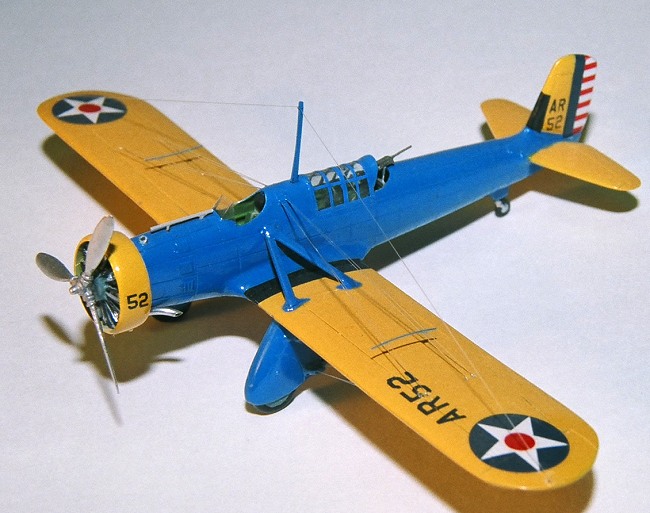
Merlin & Allied Research North 1/72 A-12 Shrikes
| KIT #: | ? |
| PRICE: | $20.00 each when new |
| DECALS: | none |
| REVIEWER: | Joel Hamm |
| NOTES: | Very short run kits |

| HISTORY |
The
last two decades or so saw the sprout, bloom, and wither of the cottage kit
industry. A half dozen mostly one-man-show operations; Pegasus, Merlin,
Meikraft, Twelve Squared, Beechnut, and Allied Research North, tried to
cash in on the willingness of experienced modelers to indulge in extensive
plastic surgery for the sake of forsaken subjects. Only the first mentioned
still survives (sort of Like Adolph Galland’s book: Die Erste und Die
Letste), but their productions still float around on Internet swap sites or
at modelers’ meets. The hush-hushness with which these operators treated
their release 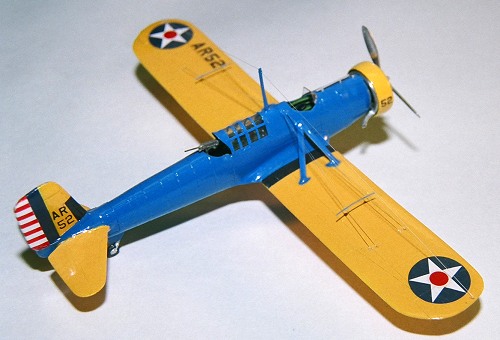 schedules occasionally backfired, resulting in duplications.
That’s what happened with the Shrike mid-war attack aircraft. Versions
were near simultaneously molded by the British Merlin Company, and the US
Allied Research North; a short-lived possible Second Coming of the Beechnut
firm, which just prior to its demise had turned out the inline engined A-8.
This build was a “best 2 out of 3”. Both versions were constructed from
the most useable portions of all 3 kits with a frequent and deep dive into
the spare parts pile. This report covers the A-12.
schedules occasionally backfired, resulting in duplications.
That’s what happened with the Shrike mid-war attack aircraft. Versions
were near simultaneously molded by the British Merlin Company, and the US
Allied Research North; a short-lived possible Second Coming of the Beechnut
firm, which just prior to its demise had turned out the inline engined A-8.
This build was a “best 2 out of 3”. Both versions were constructed from
the most useable portions of all 3 kits with a frequent and deep dive into
the spare parts pile. This report covers the A-12.
Air actions in the war had hinted at the potential of what we now call close air support, but by the time the ground-bound generals decided to cash in on the possibilities more than a decade had passed since the armistice. When they did, they found themselves frozen in a moral midstream between rapidly accelerating technology and the tried but untrue techniques of the past. Their muddlings resulted in a curious chimera: a metal moncoque fuselage still sitting on fixed, heavily spatted landing gear; a single wing sporting flaps and slats but still tuck on with struts and wires; a liquid cooed inline harnessed to a fixed pitch prop; all directed from an open front office (the A-8 did have a canopy hood but references show this deleted and say pilots generally flew with a stiff breeze on their cheeks). Before the A-8 went into full service, the designers (or at least the specifiers) decided that a big amount of drag was a small price to pay for the reliability of a round engine; ergo the radial A-12 with reconfigured cockpits and other refinements.
| THE KITS |
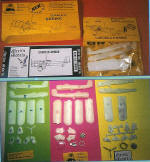 Kit
duplication is no skin off the nose of builders, because “Straight Out of
the Box” simply does not apply to early limited edition kits. The more
parts on hand, the better the chances of emerging with a reasonable replica
and an intact psyche. Step one was laying out all parts and deciding which
should go with what. Marking parts with colored “X’s” kept the sort-out
straight (see photo). All parts presented with major inaccuracies and
deformities; so selecting the least worst was a difficult process. Step 2
involved upending the spare parts bins to find better alternatives for all
the apputenances and appendiculars. Only the fuselages, airfoils, and gear
spats were kept. All small parts were scratch built or scrounged.
Kit
duplication is no skin off the nose of builders, because “Straight Out of
the Box” simply does not apply to early limited edition kits. The more
parts on hand, the better the chances of emerging with a reasonable replica
and an intact psyche. Step one was laying out all parts and deciding which
should go with what. Marking parts with colored “X’s” kept the sort-out
straight (see photo). All parts presented with major inaccuracies and
deformities; so selecting the least worst was a difficult process. Step 2
involved upending the spare parts bins to find better alternatives for all
the apputenances and appendiculars. Only the fuselages, airfoils, and gear
spats were kept. All small parts were scratch built or scrounged.
| CONSTRUCTION |
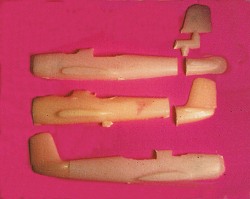 Allied
Research North’s fuselage featured an overly short and squat forward
section; while Merlin seemed to have more accurately captured the profile
of the Shrike’s schnozzola. The opposite situation prevailed regarding
vertical fins and tail cones. The obvious solution was a bit of
Frankensteinian “cut and pasting” (check photo). An inaccuracy in the
pilot’s cockpit cutout was semi-easily fixed with a sliver of sheet stock
and putty. Detailing the interior of the body clamshells was mostly a
matter of imagination, but what, besides seat, stringers, and throttle
quadrant could possibly have resided there in the real thing. Merlin also
won the toss-up in the choice of wings. The other kit’s were molded as
split
Allied
Research North’s fuselage featured an overly short and squat forward
section; while Merlin seemed to have more accurately captured the profile
of the Shrike’s schnozzola. The opposite situation prevailed regarding
vertical fins and tail cones. The obvious solution was a bit of
Frankensteinian “cut and pasting” (check photo). An inaccuracy in the
pilot’s cockpit cutout was semi-easily fixed with a sliver of sheet stock
and putty. Detailing the interior of the body clamshells was mostly a
matter of imagination, but what, besides seat, stringers, and throttle
quadrant could possibly have resided there in the real thing. Merlin also
won the toss-up in the choice of wings. The other kit’s were molded as
split 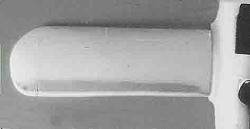 upper & lower panels, but were too short and narrow (according to an
assumedly accurate scale 3-view drawing on Merlin’s instruction sheet). The
Brit’s wing panels were solid, but suffered from a “taffy Pull” deformity –
a mid span constriction in camber and chord. The first part was fixable by
filing down the entire thickness – bringing it more in line with photos of
a razor thin, rather than Piper Cub airfoil cross section. Correcting the
width meant first filing straight both leading and trailing edges, then
restoring the proper chord with plastic strips and filler. All surface
detail was, of course, lost and had to be re-scribed. Tail feathers also
had to be thinned. Mating the re-shaped wings and empennage to their
fuselage stubs occupied many hours of carving and filling, surely inducing
errors in placement.
upper & lower panels, but were too short and narrow (according to an
assumedly accurate scale 3-view drawing on Merlin’s instruction sheet). The
Brit’s wing panels were solid, but suffered from a “taffy Pull” deformity –
a mid span constriction in camber and chord. The first part was fixable by
filing down the entire thickness – bringing it more in line with photos of
a razor thin, rather than Piper Cub airfoil cross section. Correcting the
width meant first filing straight both leading and trailing edges, then
restoring the proper chord with plastic strips and filler. All surface
detail was, of course, lost and had to be re-scribed. Tail feathers also
had to be thinned. Mating the re-shaped wings and empennage to their
fuselage stubs occupied many hours of carving and filling, surely inducing
errors in placement.
| COLORS & MARKINGS |
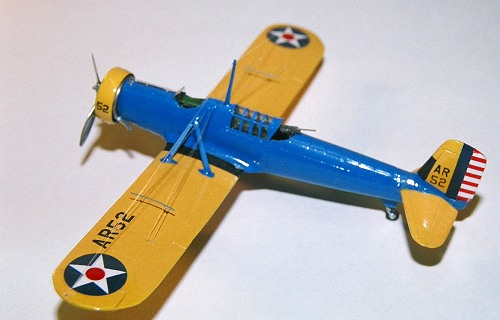 Came from
Squadron Signal’s Air Force Colors V1, courtesy of Testor’s Model
Master enamels, Superscale generic markings, and, of course, Future Acrylic
Floor Polish. Lack of a plan view reference may have induced an error in
the paint scheme. The National Air and Space Museum displays a large scale
A-8 model (most assuredly more accurate than mine) with the fuselage color
extending out on the wings as far as the strut/spat attach points. From the
painter’s perspective that would make sense, since the wings probably
bolted on at that station. If confirming references can be found, along
with the required time, energy, and impetus, the boo-boo will ultimately be
corrected with a sliver of painted decal film.
Came from
Squadron Signal’s Air Force Colors V1, courtesy of Testor’s Model
Master enamels, Superscale generic markings, and, of course, Future Acrylic
Floor Polish. Lack of a plan view reference may have induced an error in
the paint scheme. The National Air and Space Museum displays a large scale
A-8 model (most assuredly more accurate than mine) with the fuselage color
extending out on the wings as far as the strut/spat attach points. From the
painter’s perspective that would make sense, since the wings probably
bolted on at that station. If confirming references can be found, along
with the required time, energy, and impetus, the boo-boo will ultimately be
corrected with a sliver of painted decal film.
| FINAL CONSTRUCTION |
Fiddly bits were, as noted, outsourced. The Pratt & Whitney or whatever-it-was came from Engines’n’Things Resins. The Prop is a polished Aeroclub metal; the cowl donated by a demolished Monogram F-4 bipe. The Exhaust collector ring and stub were fashioned from a snippet of electrical solder, handy because the rosin core can be drilled out to create a hollow pipe. Rigging was done with so called invisible thread. Transparencies posed a closing predicament, as can be seen from the accompanying photo. Merlin’s cataraceous injected rear canopy was sanded down and used as a master for thermoforming (heat & stretch) a square of acetate. The front windshield was cut from a flat piece and trial and error (mostly error) folded & fitted to a reasonable shape.
| CONCLUSIONS |
With a three full shelf stash of intriguing models begging to be built, I have no idea what compelled me to get tangled up in this best-2-out-of-3 kit-bashing. The results look pretty good, but thanks to all the noodling needed to fix the flaws and make things fit probably wouldn’t stand up too well next to a set of accurate reference drawings. It’s only a matter of time before one of the new generation limited edition kit producers turns out a slick set of Shrikes. (MPM has one in 1/48 and will doubtless pantograph it down to 1/72).
May 2005
If you would like your product reviewed fairly and fairly quickly, please contact the editor or see other details in the Note to Contributors.